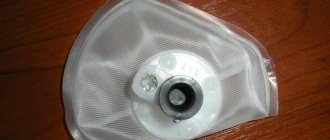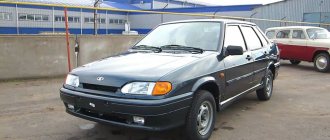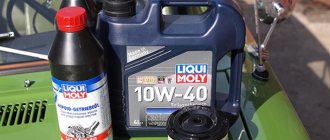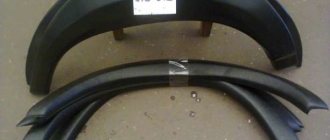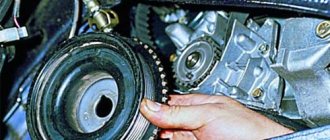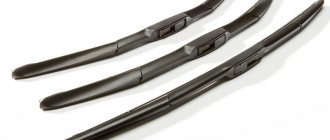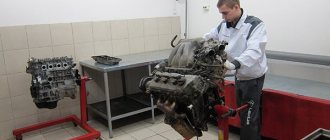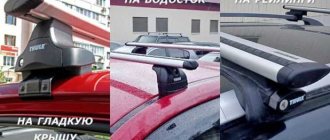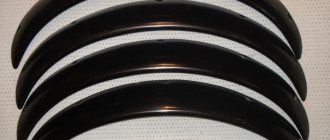Timely replacement of the air filter ensures normal operation of the internal combustion engine. This applies to internal combustion engines running on both gasoline and diesel fuel. The fact is that in order to burn one liter of fuel, the power unit needs up to 15 liters of atmospheric air (the volume depends on the engine power, the fuel used, including its quality, the condition of the ignition system, etc.). Therefore, the filter must not only do its direct job of cleaning the air, but also not interfere with its entry into the fuel path. It is this fact that is key in determining the need and timeliness of replacing the engine air filter.
This is done mainly according to clear maintenance regulations at intervals of 15...20,000 km. And on your own at home. The only exceptions are new cars that, during the break-in period, undergo technical maintenance exclusively at an official service station.
Signs of a clogged air filter
Despite the fact that there are different filters and they are installed on different engines, the signs of their clogging are almost the same.
Types of Air Filters
- Reduced engine power (reduced traction).
- Reduced dynamic characteristics of the car (it accelerates poorly when the engine speed increases).
- Increased fuel consumption.
- Activation of the Check Engine light, which can be caused either by a direct error indicating a clogged filter, or by a violation of the state of the fuel-air mixture (it is significantly enriched in fuel, error P0172).
- Significant concentration of toxic substances in exhaust gases.
In some cases, if the air filter is dirty, you may experience increased noise when the engine is running.
However, the factors listed above may be signs of other problems, but it is advisable to check the filter, especially since it is not difficult and does not take long to do.
Functions of an element in the system
For uninterrupted operation of the power plant, a suitable volume of oxygen must be used. By default, 15 kg of air is required to burn 1 liter of gasoline fuel. At the same time, it must meet a number of requirements: have the correct temperature, density, oxygen saturation and purity. Even small particles of dust can negatively affect the assembly and cause wear on new parts.
For smooth operation, the oxygen volume must be maintained.
To eliminate such troubles, air filters are used. They prevent contaminants from passing along with the air flow, and also isolate the engine from water vapor, which can enter the cylinder blocks and cause corrosion.
Under standard loads, the part reduces wear on the power unit by 15-20%, and under complex loads – by 100%.
Why replacement is required
There are several typical reasons why it is necessary to replace the engine air filter. Among them:
- Planned replacement . Each automaker individually indicates the mileage or time after which the car's air filter must be replaced. Usually the corresponding mileage is within 15...20 thousand kilometers.
- Unscheduled pollution . This may be caused either by poor-quality filter material used in the device, or by prolonged driving in polluted air conditions (dusty conditions, for example, in sand, through mud, and so on).
- Mechanical damage . It can be caused by incorrect installation, an emergency situation in the engine (in the air duct), the entry of a large particle into the filter, which disables the filter material, or damage to the filter during other repair work.
Regardless of what exactly caused the device to fail, replacing the internal combustion engine air filter will first of all eliminate the troubles described above, as well as prevent their possible occurrence in the future.
Constantly driving with a rich mixture reduces engine life (due to the fact that dust in the cylinders acts as an abrasive material). Therefore, timely replacement of the air filter is not only a repair, but also a preventive measure that allows you to operate the car engine in normal mode.
Metal
Air filter Lada Kalina 1 and 2
Metal filters are really made of steel. Or rather, from many layers of mesh into the smallest holes made of stainless steel.
Their positive points:
have good physical cleaning properties, look great, and there is no need to soak them in oil during operation;
Plus, with larger gaps between the filter media, a metal counterpart will create less resistance to airflow, especially compared to cotton and foam versions
But there are no less negative ones:
Harder to find on sale;
Expensive;
Less resistance means less filtration. If you install such a filter and drive along a dusty road, particles will get inside the engine. Of course, they will not be so large as to instantly lead to breakdown, but in this case you can forget about maximum protection.
Replacement frequency
Before moving on to general discussions, it is necessary to point out that you will find the exact frequency of replacing the air filter in the manual or technical documentation for your car . In addition, there are a number of objective factors that influence the mentioned values. These include operating conditions, the use of different filters, as well as differences in engine type - they are different for gasoline and diesel engines.
For cars with an injector, for diesel engines, and especially for diesel engines with turbocharging, the mileage for an air filter to be replaced, after how long it needs to be done, is reduced by 20...30%, for diesel engines with a turbine even by 50%.
In most cases, on gasoline engines, the air filter is replaced after 15...20 thousand kilometers. On diesel engines, respectively, after 10...15 thousand . However, according to numerous reviews from domestic car owners, especially those living in large cities and industrial areas, the mileage indicated in the manual should be reduced by up to two times. Therefore, if your car shows these typical signs of a clogged filter, it makes sense to check its condition and replace it if necessary.
As for diesel engines, they do not have a throttle valve. Because of this, the air consumption in them is significantly higher. And if a diesel engine also has a turbine, then it more actively sucks in air from the atmosphere, which in itself accelerates filter clogging. Similar reasoning is valid for cars equipped with mechanical superchargers (for example, some models from Honda, Mini Cooper, Volkswagen, Audi, Mercedes Benz).
Many car enthusiasts combine replacing the air filter and changing the engine oil (that is, every 10...15 thousand kilometers).
Where to look for it
How to replace the cabin air filter? If it's located in a convenient location, then it's easy. Most often, cabin filters are located inside/behind the inner wall of the glove compartment. It is not difficult to replace it. It is enough to remove the glove compartment (you don’t have to completely remove the dashboard) to get the element; instructions should be in the manual.
If the filter is deep under the dashboard, it will be difficult to get there, and there is no way to do this without specialists. There are also those located in the space under the hood, then replacing them is not difficult. Here, too, there is no point in bothering with purchasing an expensive original.
It’s easier to purchase an affordable analogue at your local store, just like a regular filter.
That’s all for me, friends, at what mileage filters are changed you now know, and you can replace them, subscribe to site updates, and recommend that your friends subscribe, they might find it useful, share links to this article and others, see you.
Replacement methods
Round air filter for carburetor engines
There are two main ways to replace the air filter. The first is to delegate this procedure to the masters at the service station. However, due to the obviousness, we will not consider it. Let’s just say that the cost of such a replacement is usually calculated based on standard hours (each technical center may have its own calculation method and different standards based on the specifics of the work and the brand of the machine) and the cost of the filter itself. Moreover, service centers often force car owners to buy filters only directly on the spot, and their price there may be higher than the market price. On average it is from 0.2 to 0.5 n/h, with a cost of 1800 rubles. for 1 standard hour of work, and in some cases the price of such a procedure is included in the cost of an oil change.
On average, as of spring 2021, the cost of replacing an air filter in the Russian Federation ranges from 500 rubles and above (depending on the car model, the complexity of the replacement, and so on).
The second way is to perform the procedure yourself. In terms of money, this is much more economical, since in this case you only pay directly for the filter itself. Where to buy an air filter cheaply is up to you to decide. The procedure is simple, but special tools are required to perform it.
Types of filters
Modern filters installed on engines differ in design and in the way they purify the air. By design, filters are:
- Panel - like on an injector;
- Ring - like on a carburetor;
- Cylindrical or conical - on racing cars or sports cars (as well as trucks);
They can be classified according to the material of manufacture and the method of purification:
- Made from paper/cardboard. This is by far the most budget-friendly and therefore widespread option. The filter element is porous paper/cardboard, which can trap the smallest dust. Special impregnation allows the paper not to lose its properties when in contact with oil, gasoline or water. The material is folded like an accordion and has many layers to make the usable area larger. Such an element cannot be restored; cleaning and blowing it still will not clear out the dust stuck in the impregnation and stuck in the micron holes. Therefore, after the expiration date, it is simply thrown away.
- Inertial elements. Today, these filters are rarely used, mainly in older car models. Inside the filter housing there is a kind of washcloth made of fishing line. The air flow passing through it is forced to sharply change direction, losing debris in the process. The largest particles will end up at the bottom of the body, while the rest will get stuck inside the washcloth. The filter was simply washed, cleaned, dried and it was ready for use again. In an improved version, a little oil was poured onto the bottom of the housing so that dirt particles would stick to it and the air would be purified better.
- Elements of "Zuleviki". Their design is similar to that of their paper counterparts. Here, instead of paper, multilayer fabric (like gauze) with special impregnation or foam rubber is used. It is many times more expensive than paper ones. This is mainly why it is not used in ordinary cars. They have found application in racing and sports cars due to the least resistance to air flow through them and the best throughput.
- Cylindrical filters are less common and are more common on trucks. The replacement is similar to a regular cardboard element and the composition is mainly cardboard. Blowing, temporary solution, replacement according to deadlines, of course.
Any novice driver can purchase the necessary element. Look under the hood or in the manual that came with the car.
DIY instructions for replacing the air filter
First of all, to begin the procedure for replacing the engine air filter, you need to collect the required tools and materials. Among them:
- a new air filter (when purchasing, make sure that it fits your car exactly in size, it may not necessarily be original);
- a screwdriver with a flat blade (instead, you may need a Phillips blade or not at all, depending on the type of fastening of the filter box cover);
- clean rags;
- compressor (preferably, but if you don’t have one, you can do without it);
- dust brush (also optional).
On some cars (for example, Renault Kangu, VAZ Kalina, Renault Megane), the body is additionally fixed in the seat using fasteners, bolts, plastic latches and metal clamps... In this case, you need to take care of the availability of tools. On a “Kangoo” car, the cover of the box with the filter is secured with bolts under “Torex” T27 or, in common parlance, with an asterisk.
Naturally, each car (and sometimes the same model, but with different engines) will have its own characteristics in fastening the filter housing and some nuances. However, in most cases (given that the procedure for replacing the filter is simple), the algorithm of actions will be as follows:
- Place the car on a level surface, set the handbrake and turn off the engine.
- Open the hood.
- Unscrew the screws securing the air filter cover and then remove it.
- Carefully remove the old air filter so that dust and debris from it do not get into the air line or onto other elements of the engine compartment.
- Cover the inlet pipe with some rag.
- Use a compressor to blow out dust from the air filter housing. Instead of a compressor, you can use a brush or combine both.
- Remove the rag from the inlet pipe.
- Install the new filter in its seat.
- Reassemble the structure in reverse order.
In extreme cases, you can try to clean the old air filter as much as possible instead of buying a new one. However, this is only suitable if it is not possible to purchase a new spare part .
How to replace the air filter housing on a VAZ 1117-VAZ 1119?
When removing the case, you will have to do a little work with the electronics, so at the very beginning we recommend that you remove the negative terminal from the battery! (For information on how to remove the terminal, see the article: Replacing the battery on a VAZ, point 1)
1) First you will need to disconnect the Mass Air Flow Sensor, because if it is not disconnected from the housing, it will be chained to it and thus you will not be able to remove the housing, in order to disconnect the sensor (Indicated by a blue arrow) from the housing indicated with the red arrow, press the latch from below that secures the sensor and then pull it, disconnect it from the place where it is located.
Buy or clean?
There is a misconception among craftsmen that the air filter can be blown out, washed and put back. Water or a strong stream of air will not clean out the pores of the paper filter. Such dubious savings lead to disruption of the normal operation of the engine. If the filter is clogged, it needs to be changed .
Do not saturate the filter element with additional oil - this will not improve filtration. Oil will clog the pores of the paper web and increase resistance to air suction. The mixture in the engine combustion chamber will become richer, fuel consumption will increase.
When purchasing an air filter for your car, examine the packaging. On the box, the manufacturer of a quality filter must indicate the barcode, make and model of the car . An original consumable is preferable, but a licensed auto part will do just as well. When choosing, be guided by the “price-quality” criterion.
